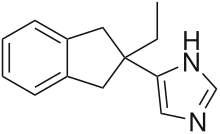Atipamezole
 | |
 | |
| Clinical data | |
|---|---|
| Trade names | Antisedan, others |
| AHFS/Drugs.com | |
| License data |
|
Reversal agent | |
| ATCvet code | |
| Legal status | |
| Legal status | |
| Pharmacokinetic data | |
| Metabolism | Liver |
| Onset of action | Less than 3 min. |
| Elimination half-life | 2.6 hours (dogs) |
| Excretion | Kidney |
| Identifiers | |
| |
JSmol) | |
| |
| |
| | |
Atipamezole , sold under the brand name Antisedan among others, is a synthetic
It was originally released in 1996.
Medical uses
Atipamezole is a veterinary drug whose prime purpose is to reverse the effects of the sedative
Atipamezole is licensed in the United States for
Atipamezole has also been used as an antidote for various toxicities in dogs. For example, the anti-
Available forms
Atipamezole is sold at 5 mg/mL for ease of use: 5 times as much atipamezole as medetomidine is needed for full reversal, and because medetomidine is sold as 1 mg/mL, 1 mL of atipamezole reverses 1 mL of medetomidine.[23] When the enantiomerically pure version of medetomidine (dexmedetomidine) was released, it was sold at 0.5 mg/mL, because it was twice as strong as medetomidine. As such, 1 mL of atipamezole also reverses 1 mL of dexmedetomidine.[10][12]
Specific populations
Atipamezole is not recommended for animals that are pregnant,
Contraindications
While there are no absolute contraindications to atipamezole, it is recommended against being given with
Side effects
Atipamezole's low rate of side effects is due to its high specificity for

There is a possibility of the sedation reversing abruptly, leading to nervous, aggressive, or delirious dogs.[9] Such cases are more associated with intravenous administration[29] (which has a faster onset than IM administration). The rapid administration of atipamezole leads to sudden displacement of dexmedetomidine from peripheral ɑ2-adrenergic receptors; this can cause a sudden drop in blood pressure, which is followed by a reflex tachycardia and hypertension.[12][26][30]
There have been some cases where intravenous administration of atipamezole lead to death via
There is some possibility of the animal relapsing into sedation after being given atipamezole, made more likely if the original sedative was given intravenously.[9]
Rats and monkeys have experienced increased sexual activity after being given atipamezole.[31][32]
Overdose
The
Pharmacology
Mechanism of action
Atipamezole reverses analgesia by blocking norepinephrine feedback inhibition on nociceptors.[12][31]
| Site | Ki (nM) | Species | Ref |
|---|---|---|---|
| α1 | 3160 | Human | [35] |
| α2A | 1.9 | Human | [36] |
| α2B | 2.2 | Human | [36] |
| α2C | 4.2 | Human | [36] |
| The Ki refers to a drug's affinity for a receptor. The smaller
the Ki, the higher the affinity for that receptor. | |||
Pharmacokinetics
Out of the three ɑ2-antagonists commonly used in veterinary medicine (atipamezole, yohimbine, and tolazine), atipamezole shows the highest preference for ɑ2- over ɑ1-receptors, binding to them with a ratio of 8526:1.[12] It shows no preference for a particular ɑ2-receptor subtype.[31]
Atipamezole has a rapid onset: it reverses the decreased heart rate caused by sedation within three minutes. The animal usually begins waking up within 5–10 minutes. In a study of over 100 dogs, more than half could stand up within 5 minutes, and 96% could stand up within 15. Atipamezole reaches maximum serum concentration within 10 minutes of IM administration.[9] Atipamezole is distributed extensively to the tissues; at a particular time, concentrations in the brain reach two to three times the concentration in the plasma.[27]
Atipamezole undergoes heavy
The elimination half-life is 2.6 hours in dogs and 1.3 hours rats.[9][20]
Research
Atipamezole's effects on
Because atipamezole increases sexual activity in monkeys, there have been claims of its potential to treat erectile dysfunction.[32]
Notes
- ^ Because dexmedetomidine is the only pharmacologically active component of medetomidine, they will both be referred to as dexmedetomidine from here on out.
References
- ^ "Antisedan Product information". health-products.canada.ca. 24 March 2011. Retrieved 5 April 2024.
- ^ "Antisedan- atipamezole hydrochloride injection, solution". DailyMed. 18 June 2020. Retrieved 5 April 2024.
- ^ "Contrased- atipamezole hydrochloride injection, solution". DailyMed. 1 March 2024. Retrieved 5 April 2024.
- ^ "Cropamezole- atipamezole hydrochloride injection, solution". DailyMed. 26 December 2023. Retrieved 5 April 2024.
- ^ "Revertased- atipamezole hydrochloride injection, solution". DailyMed. 14 September 2023. Retrieved 5 April 2024.
- ^ "Revertidine- atipamezole hydrochloride injection, solution". DailyMed. 12 January 2023. Retrieved 5 April 2024.
- ISBN 978-1-4377-0282-8.
- ^ "Atipamezole". Drugs.com. Retrieved 7 August 2019.
- ^ a b c d e f g h i "Antisedan for Animal Use". Drugs.com. Retrieved 24 February 2018.
- ^ a b Cote 2010, p. 1623.
- ^ ISBN 978-1-4377-0192-0.
- ^ ISBN 978-0-8138-2061-3.
- ISSN 0003-2999.
- PMID 15516790.
- S2CID 25527884.
- ISBN 978-1-4557-7399-2.
- ISBN 978-0-323-24293-6.
- ISBN 978-1-4200-0952-1.
- ISBN 978-0-12-370467-2.
- ^ a b c d Bahri L (May 2008). "Pharm Profile: Atipamezole". Compendium. 30 (5).
- ISBN 978-0-12-370467-2.
- ^ Cote 2010, pp. 126, 285.
- ^ ISBN 978-0-7020-5423-5.)
{{cite book}}: CS1 maint: DOI inactive as of January 2024 (link - ISBN 978-0-16-072065-9.
- ^ ISBN 978-1-4377-1448-7.
- ^ ISBN 978-1-118-27933-5.
- ^ PMID 16389294.
- ISBN 978-1-59161-034-2.
- ^ Fish 2008, p. 371.
- ISBN 978-1-4160-6477-0.
- ^ a b c d Fish 2008, pp. 53–54.
- ^ ISBN 978-0-08-058378-5.
- ^ "Safety Data Sheet" (PDF). Zoetis. 20 March 2017.
- ISBN 978-0-7506-8812-3.
- PMID 1656026.
- ^ PMID 20809632.
- PMID 11854148.
- ISBN 978-1-4377-0195-1.
Further reading
- Cote E (2010). Clinical Veterinary Advisor – E-Book: Dogs and Cats (2nd, revised ed.). Elsevier Health Sciences. ISBN 978-0-323-06876-5.
- Fish RE (2008). Anesthesia and Analgesia in Laboratory Animals. American College of Laboratory Animal Medicine series. Academic Press. ISBN 978-0-12-373898-1.
External links
 Media related to Atipamezole at Wikimedia Commons
Media related to Atipamezole at Wikimedia Commons
